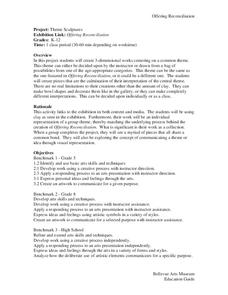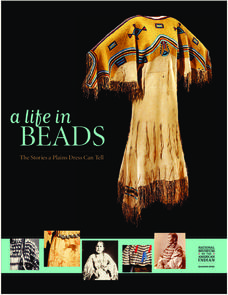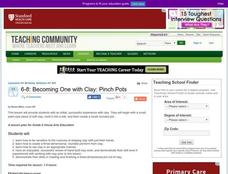Curated OER
Visual Arts Lesson -Wardrobe
Learners define the term neoclassism and locate examples of it in furniture design. They research and explain the role of the wardrobe in viceregal Mexico. Pupils compare and contrast the use of wardrobes as storage in the earlier...
Curated OER
What's in a Willow?
Learners study of nutritional value of edible native plants. discriminate between foods that have nutritional value and those that do not. They relate how food can affect how they think, feel, and perform.
Curated OER
Alexander and the Terrible, Horrible, No Good, Very Bad Day
Students investigate storytelling by analyzing images in a book. For this reading analysis lesson, students read and analyze the book Alexander and the Horrible, No Good, Very Bad Day. Students observe the illustrations in...
Curated OER
Counterpoint Activities: Listening and Discussion
Students assess whether or not a piece of music is contrapuntal. In this music education lesson, students listen to various pieces of music and identify whether the music is contrapuntal or not contrapuntal.
Curated OER
In Search of Shakespeare . Images of Othello: A Shakespearean WebQuest | PBS
Students look closely at the text of "Othello." They use an online dictionary, and use various search engines. Students use an online Shakespeare concordance and make intelligent decisions about character. They write an intelligent...
Curated OER
What's in a Word?
Young scholars complete a unit on words, their origins, and their usage. They explore various websites, create a word ladder online, develop a list of anagrams, write a story using homonyms, and create a list of vocabulary words.
Curated OER
How Could You Visualize the Importance of Education
Learners view different pieces of art from artist Candida Alvarez. They discuss what the art means to them. They create their own mobiles showing what they would like out of their education.
Curated OER
What's In A Name: Art That Honors Achievement
Young scholars examine a quilt by artist Faith Ringgold. They discuss what story is told by the quilt. They create their own collage quilt showing a person for whom a building in Bronx is named.
Curated OER
Visual Arts:Literature and World Civilization
Fourth graders examine the art of the Middle Ages or Medieval time period through the activities in this unit.
Curated OER
Theme Sculptures: Offering Reconciliation
Students create 3-dimensional works in clay. In this sculpture lesson, students discuss a theme and create a sculpture based on that theme. Students express personal ideas and feelings through the arts.
Curated OER
Seeing the Invisible: Angels and Demons
Students search for angels and demons within the paintings in the Getty's medieval and Renaissance galleries. They examine the ways that artists made these invisible creatures visible.
Curated OER
Making Furniture That's Fit for a King
Students study the furniture made in the 1600s and 1700s for wealthy Parisians and the King of France.
Curated OER
The Museum Idea
Students discover the nature and uses of museums by completing several creative projects. Students also analyze abstract art with teacher guidance.
Curated OER
Complementary Color Portraits
Students create complimentary color portraits using crayons in this elementary school Art lesson about the use of complimentary colors. The lesson includes an example of complimentary art, recommended books, and a downloadable color wheel.
Curated OER
Introduction to Ludwig van Beethoven
"Ode to la Tortilla" and "Ode to Joy"? Sure! Use Gary Soto's poem to introduce learners to the ode format. After examining the descriptive words Soto uses, class members study a poster of Ludwig van Beethoven, suggest words that describe...
Johnson County Community College
Treasured Stories by Eric Carle
Explore the works of Eric Carle with a set of four lessons focused around the stories, Brown Bear, Brown Bear, What Do You See?, Papa, Please Get the Moon For Me, and The Very Hungry Caterpillar. Young readers develop a storyboard,...
Curated OER
Clowing Around: Ceramics
Clowns are a big hit with kids! Explore a few circus related websites to get an idea of how clowns look and what they do. They then build sculpting skills by creating expressive clown faces out of clay. Web links, materials list, and...
Smithsonian Institution
A Life in Beads: The Stories a Plains Dress Can Tell
Young learners discover how the Sioux and Assiniboine tribes preserved native culture through the making of traditional dresses, identifying the resources used to make the dresses and discussing behind the meaning behind some...
Curated OER
Who am I Mobile: Ceramics
A getting-to-know-you activity that is perfect for the beginning of the year! Kids craft their portrait out of clay, then make a mobile by dangling ceramic representations of things they love. This project builds self-awareness, motor...
Missouri Department of Insurance
Health Insurance
Confused by how health insurance works? This informational pamphlet and worksheet from the Missouri Department of Insurance offers explanations and examples to help future adults make important decisions regarding health insurance.
Curated OER
The Sorcerer's Apprentice: 200 Greatest Pop Culture Icons
Upper graders view the animated short, "The Sorcerer's Apprentice" and analyze how the music score was chosen to express the scene. They create an animation as they listen to a classical recording to experience the connection between...
National Mississippi River Museum & Aquarium
Sun Printing
Ozalid acid paper is sensitive to the light. It reacts by getting darker, and it's the same paper photographers use when they print their pictures. Here, kids get to use photo-sensitive paper to create sun prints to find out...
Missouri Department of Elementary
Character Clovers
Build a classroom community with a lesson that uses character clovers to examine scholars' roles. Following a whole-class discussion, participants list four roles they play and accompany it with the character traits that go along with...
Curated OER
Becoming One With Clay: Pinch Pots
Explore the making of a pinch pot using this resource. Learners discuss the properties of clay, including its molecular structure. Then, they make their own clay pot. As they work, they identify the techniques used to make a pinch pot,...

























